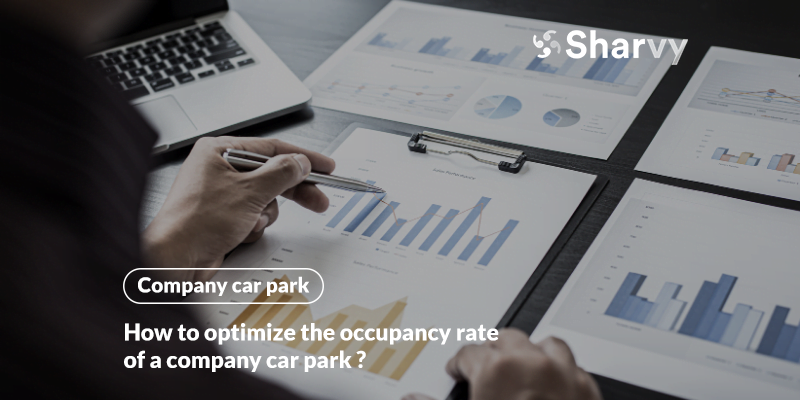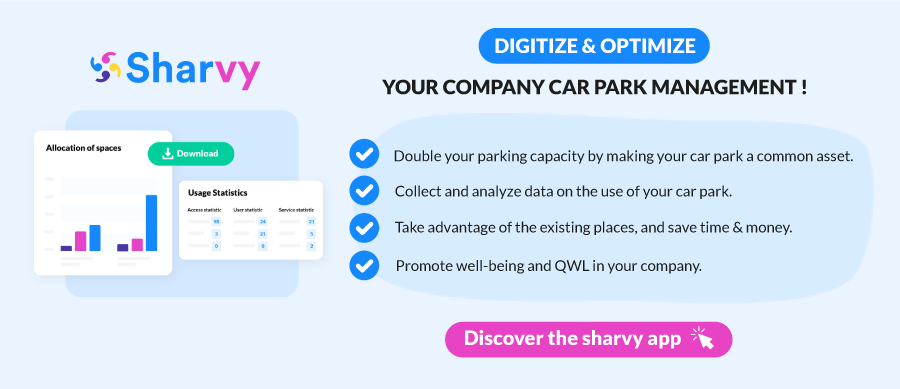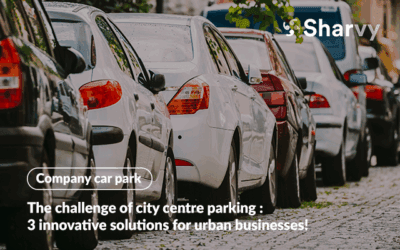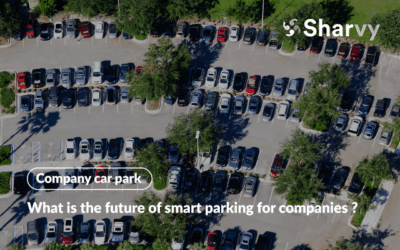Faced with the abrupt change in working patterns in recent years, companies have had to overcome many challenges quickly. The most striking? The transition from a traditional work organization to a hybrid model. A change that has caused a flood of questions within companies.
However, whether perceived as a managerial, organizational, or even legal headache, hybrid work is now a new reality, shaking up employee mobility practices and introducing new rituals.
At the same time, the arrival of new means of self-service transport (electric scooters, electric bicycles, shared cars, etc.) combined with employees’ growing need for flexibility (teleworking, flex office, hot desking, etc.) is turning the way companies manage their parking facilities upside down.
If companies do not address this issue and leave their car park(s) management to follow, they face substantial costs and a decreasing occupancy rate.
This is why they must now rethink their operating methods to optimize the benefits and limit the negative impacts of hybrid working.
The starting point? The occupancy rate of the company car park. In this article, we decipher how to analyze & optimize it to take advantage of it and make savings!
The company car parks paradox : empty and expensive?
Before continuing, a bit of context is in order. First, remember that today, the combination of face-to-face and remote work is part of the daily life of 55% of employees, according to the 2022 Barometer of the JLL company. The same study also reveals that 45% of employees juggle between working in a third place (coworking and corpoworking), working at home, and working in person.
As a result, employee mobility is increasing, and office attendance is decreasing.
This new reality is leading to a decline in the occupancy rate of workspaces and the correlation between company car parks.
As a result, it is estimated that 1/3 of the time, parking spaces in the company car park still need to be occupied. For various reasons : teleworking, illness, business trips, family emergencies, etc. This can lead to frustration, annoyance, and internal conflicts in the long term.
So, company car parks need to be more utilized and better optimized, which leads to unnecessary expenses or even additional costs for the company.
This is why it is called a paradox : car parks are empty yet expensive for the company.
The solution? Start by understanding the mobility needs of your employees and analyzing the occupancy rate of your company car park to make the right decisions.
Before continuing, a reminder : what is the occupancy rate?
The occupancy rate is a performance indicator measuring the occupancy of an entity about its total capacity over a given period. However, this definition remains very broad! So let’s apply a concrete example to the entity in question, i.e., the company car park.
It should be noted that there are generally two types of occupancy rates :
- Theoretical occupancy rate : this corresponds to the number of reservations and permanent accesses minus the number of parking space releases.
- The real occupancy rate : as the name suggests, this corresponds to the number of parking spaces occupied over a given period. You can observe it thanks to a history of requests to open the barriers of your car park, or via seat occupancy sensors.
Why and how to analyze the occupancy rate of your company car park?
Before you read this article, analyzing the occupancy rate of your company car park was not a priority. However, regular monitoring of the occupancy rate allows you to be alerted, at the right time, to the changing needs of your employees.
The aim is to make the right decisions in time and adapt your parking policy accordingly.
But how do you go about it? The analysis of the occupancy rate can be done in several ways. It depends on your situation. For example :
- If you have a dedicated parking management solution, such as Sharvy : a tab within the application lets you get an overview of various statistics. In this tab, you will find your car park’s occupancy rate. For a more detailed analysis, it is interesting to observe this occupation per day, per hour (for example, on a typical day), and also to make an average according to the days of the week. This can be done by distinguishing the different types of spaces. At the same time, it is also a good idea to monitor the activity of your employees, distinguishing between those with a named seat, employees with access by reservation, and visitors.
- If you do not have a solution dedicated to managing your car park : the occupancy rate analysis can be more constraining. On the one hand, it must be done “by hand” using your tool (Excel spreadsheet, for example). On the other hand, regular monitoring is necessary, which requires more time. To calculate this, and get the real occupancy, you only need to look at the history of gate opening requests.
How to optimize the occupancy rate of your company car park?
1. Interpret your occupancy rate (correctly) !
Calculating your occupancy rate is only the first step. To optimize it appropriately, it must first be adequately interpreted.
To do this, start by observing the ratio between the number of theoretical arrivals and the number of spaces in your car park.
If the ratio is high, this may indicate tension in your car park. However, if this tension reflects reality, corrective measures should be adopted.
For example, you can decide to make the requests for parking spaces more fluid by adapting your teleworking policy. Another option is to remind people of good practices. For example, a user may only show up if they have reserved a parking space. If several users behave this way, this saturates your car park because a reserved space is not used, nor can other users use it. In correlation, this also affects your actual occupancy rate.
On this point, the Sharvy solution allows you to mitigate these inconveniences. For example, putting the parking space in question back into the “common pot” and at the disposal of other users when the user with a reservation does not show up.
On the other hand, if this ratio is low, and only some of your employees have access to your car park (yet), you can consider giving them access in the form of a reservation. In this way, you promote equity and improve their Quality of Life and Working Conditions (QLWC). At the same time, you end the traditional allocation criteria based on seniority and/or hierarchy. You can easily do this with a dedicated parking management application like Sharvy.
✔ Our advice :
Ultimately, keep in mind that good interpretation is key. The decisions that result from this analysis will help maintain a positive parking experience for users, avoiding recurring problems with parking management.
2. Pool your spaces to optimize the occupancy rate of your company car park
Remember one important point: more permanent accesses are needed to limit the number of spaces available for users with access by reservation.
Consequently, to optimize the use of each parking space, it is wiser to share your parking spaces with all your employees and visitors! However, it is common for a few employees (e.g., members of the Executive Committee & Management Committee) to retain permanent access to the company car park.
However, if you receive recurrent complaints (e.g., from users who cannot obtain a reservation), but at the same time, your actual occupancy rate is low, this should alert you!
✔ Our advice :
This may mean that car park holders must play the game and release their parking space while away. If this is the case, consider identifying these users and offering them access to the car park by reservation only. This is a sensible adjustment and may be more appropriate to the real needs of these users.
In the opposite case, think about communicating to users with permanent access the importance of freeing their parking space in case of absence.
3. Make access to your company car park easier and more fluid!
For most companies, the main concern remains the safe reception of visitors, staff, and customers. However, more is needed to control the comings and goings of users. Therefore, it is important to install a vehicle access control system.
This is, of course, justified: nowadays, there are more and more ways to enter a company. Whether it is the simple entrance “door,” the emergency lanes, the car park(s), or the delivery and/or unloading areas, these are all access points that ultimately complicate users’ reception and parking experience.
Therefore, if your company car park is under-optimized, it may be due to its accessibility. Queues at the car park’s lift gates are (still) regularly observed and complex and/or slow means of identification.
If this is the case for you, you must make access to your company car park more fluid and easier. This can help you to optimize your occupancy rate.
✔ Our advice :
To make access to your car park more attractive, you can give priority to :
- Cameras with number plate recognition : when a vehicle authorized to enter the car park approaches, the security barrier opens automatically. Users do not waste time looking for badges and/or RFID cards. Therefore, access to the car park is smoother and faster, especially during peak hours.
- The IoT module is linked to a dedicated application, such as Sharvy : In this case, your employees’ phone becomes a remote control, capable of opening the gate and/or the security barrier. Only if the user is authorized to access the company car park. In this way, you modernize your access control, make it easier for employees and visitors to come to the site, and limit long waits in case of stolen/lost badges and/or access cards.
However, if you need clarification on the benefits and effectiveness of these access control solutions, please see one of our dedicated case studies. For example, since 2019, Sharvy has been supporting the Atlantic Group in optimizing the occupation of the 87 parking spaces at its Paris headquarters, which houses 250 employees.
4. Give more importance to multimodal travel!
As a company, you have a direct impact on the mobility of your employees.
It is therefore important to rethink the uses of your car park. On the one hand, to optimize its occupation by adopting a reliable and fair parking policy. On the other hand, to encourage rotation in parking spaces.
Giving priority to this point leads to a lesser reluctance on the part of car park holders to vacate their spaces and to make greater use of soft mobility to get to work (public transport, bicycles, company carpooling, etc.). Again, this is done without losing the use of the parking space, which encourages multimodality.
As a result, you transform the passive management of your car park into a real space for sharing between your employees. This not only improves the attractiveness of your company car park but also promotes multimodality and thus increases your occupancy rate.
✔ Our advice :
To go further and increase the number of multimodal journeys, consider installing charging points for electric cars to encourage electric mobility within your company.
With the advent of electric and plug-in hybrid vehicles, the number of charging stations is increasing. As of June 2022, all new buildings in the UK, as well as those undergoing major renovations with more than 10 parking spaces, will be required to have a charging point. To support this approach, companies can benefit from the Workplace Charging Scheme (WCS), offered by the Office for Zero Emission Vehicles (OZEV). This reduces the cost of purchasing and installing a charging point at the workplace by 75% (capped at £350 per socket).
At the same time, remember the importance of versatility within your car park. So, in addition to shared charging stations, install various infrastructures, such as a fleet of bicycles, two-wheeler parking facilities, lockers for any luggage, and a secure space for parking bicycles, electric scooters, and NEVs (New Individual Electric Vehicles). This way, your employees will be more encouraged to use them. In addition, you make your car park a hub for mobility and various services.
5. Develop a reliable, fair, and efficient parking policy!
One of the last solutions to optimize your car park’s occupancy rate is to develop a reliable parking policy adapted to your company.
For example, by adopting dynamic and fair management of your car park. Your employees anticipate their presence at the company and foresee if they need parking. The Sharvy application allows you to excel in this management and works as follows :
- If an employee has a parking place and plans to be absent from the office they will responsibly & independently release the seat and return it to the “common pot.”
- Conversely, if the employee requests a space, they will make a request (via the Sharvy application) and be allocated a space according to a fair algorithm.
The advantage of such an application is that it gives your employees a view of the availability or unavailability of parking spaces. This allows them to anticipate (up to 4 weeks in advance) and choose their means of transport accordingly.
Thus, if your car park is rather tightly packed, and an employee cannot obtain a reservation for a specific day, they can choose public transport, carpooling, or even a two-wheeler (bicycle, motorbike, electric scooter). This vision allows them to anticipate their trips and avoid spending time looking for a parking space each morning.
✔ Our advice :
Today, by integrating digital technologies, the possibilities for managing your company car park are infinite! For example, you can imagine rules of good use, systems of prioritization or sharing of spaces between users, rules of equity, etc.
If you are wondering about this, contact our Sharvy experts and/or ask for a demonstration of the solution!
To delve deeper into this discussion with practical examples, let’s consider two scenarios for improving parking space management:
In the first case, a company could designate specific spots with charging points in its car park, reserved exclusively for electric vehicles. Using a mobile application for booking and managing these spaces would encourage efficient use and optimal rotation, while supporting sustainable mobility initiatives.
In a second example, introducing dynamic signage and variable pricing could transform the efficiency of the car park. These technologies would guide drivers directly to available spaces and adjust pricing based on demand, thereby improving user satisfaction and reducing search times for parking.
What conclusions can be drawn?
There is no doubt that the mobility habits of your employees are changing. In addition, the spread of teleworking and the introduction of the flex office impacted work organization.
As a result, your company’s parking requirements are also changing. As a result, it makes sense to modernize & digitalize its management, for example, by adopting smart parking solutions, such as Sharvy.
This type of solution allows you to analyze, in a precise way, the occupation of your company car park. Furthermore, this enables you to obtain clear and detailed reports while defining access rules adapted to your company and specific to your employees’ needs!
Have a question? Check out the FAQ!
What is a "good" occupancy rate for a company car park?
A “good” occupancy rate is close to 100%. However, a rate of over 90% reflects a well-optimized company car park, with a parking policy that meets the mobility needs of your employees.
However, if your occupancy rate falls below 70%, then it is imperative to review the management of your company car park. In particular, you are rethinking your parking policy (if you already have one). If you don’t have one yet, it may be a sign that you need one, especially if you receive recurring employee and visitor complaints.
Finally, if your occupancy rate fluctuates between 70% and 90%, note that adjustment measures should be considered to raise this score. To help you improve it, Sharvy experts are at your disposal, do not hesitate to ask them for advice by making an appointment!
What are the advantages of optimising the occupancy rate of my company car park?
There are benefits for both the company and the employees.
On your side (company), by regularly monitoring the evolution of your occupancy rate, you will be able to make discoveries about the management of your car park and thus target the measures to be taken to improve its operation. For example, you limit the number of vacant parking spaces and avoid the substantial costs of a fallow car park. This will allow you to save money and allocate the budget to other investments. For example, to develop a service hub within your car park (car wash, bike and/or scooter rental, etc.).
On the employee side, you improve their well-being and quality of life at work. In particular, by monitoring the occupation of your car park, you can take appropriate measures, strengthen its management and decide to increase the number of users accessing it. In addition, you will save them time, as they will not have to search for a space near the premises. On a day-to-day basis, the time involved in this search can be time-consuming, stressful, and restrictive.
What tools can help you analyse the use of your company car park?
To effectively analyse the use of your company car park, there are a number of tools that can help you gain a clear and usable picture :
- Connected sensors : these IoT devices track occupancy rates in real time, identify peak times, and pinpoint under-used or saturated areas. They provide instant visibility so you can quickly adjust your policies.
- Car park management software : these tools (such as Sharvy) centralise data and offer analytical dashboards to visualise trends, automate reservations, and generate detailed reports on usage patterns.
- Collaborative surveys and feedback : supplement technical data with qualitative feedback to identify user frustrations, co-construct appropriate solutions, and ensure better adoption of improvements.
By combining these tools, you can obtain both figures and user feedback, which are essential for optimising the use of your car park.
Want to learn more? Check out our latest articles!
The challenge of city centre parking : 3 innovative solutions for urban businesses!
Urban businesses : what solutions can be found to meet the challenge of city centre parking? Our advice and tips in this article!
The office as a branding tool : how can it reflect your corporate culture?
Is the office an underestimated branding tool? How can your spaces embody your culture & reinforce your brand image? Focus!
What is the future of smart parking for companies ?
What is smart parking for companies? What trends will shape the future? And why? All the answers in this article!
Subscribe to our newsletter!
Resources
Contact us
+44 117 463 6990






